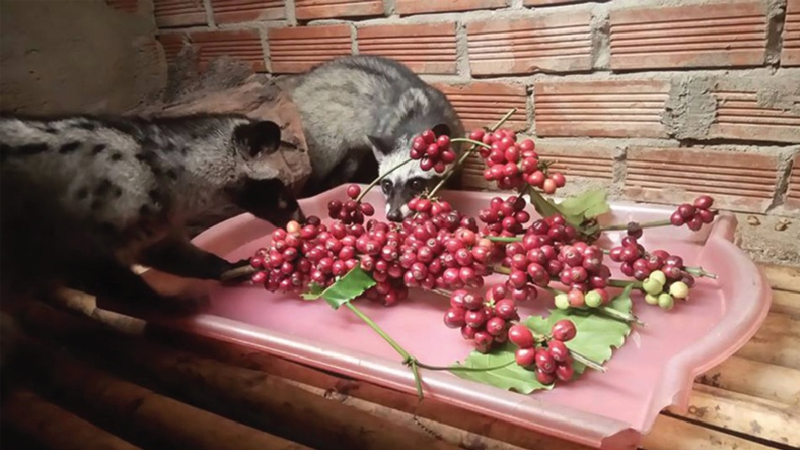Coffee is a ubiquitous beverage, with many of us relying on our daily morning cup of black iced coffee or iced milk coffee to boost our energy and keep us alert throughout the day. However, amidst the myriad of coffee varieties, one unique and exquisite type stands out: Civet Coffee, a favorite among connoisseurs for its distinct flavor and intriguing production method.
1. Unveiling Civet Coffee:
Civet Coffee, also known as Weasel Coffee, is an extraordinary brew derived from coffee beans extracted from the droppings of civet cats. This unusual process begins with ripe coffee cherries, which are fed to civets known for their exceptional sense of smell. These discerning creatures selectively choose the finest cherries, consuming only the flesh and beans while discarding the skin.
 Civet Coffee, also known for its alias, Weasel Coffee
Civet Coffee, also known for its alias, Weasel Coffee
The civet cat’s digestive system is unable to fully break down the coffee beans, leading to an unexpected benefit. The beans undergo a natural fermentation process in the civet’s stomach, aided by enzymes, resulting in harder, crispier beans with a reduced protein content. This transformation imparts a singular aroma and flavor to the beans, setting them apart from conventional coffee beans.
The origins of Civet Coffee, or Kopi Luwak as it is also known, can be traced back to Dutch colonists in Indonesia, specifically the island of Java. While the locals were forbidden from consuming the coffee beans, they observed that the civet cats, or Luwak, would eat the cherries and excrete the beans intact. Thus, the colonists began collecting, drying, and roasting these beans for their exclusive use, coining the term “Kopi Luwak” in the process.
Types of Civet Coffee Beans:
– Wild Civet Coffee: This rare variety is produced from civet cats living freely in their natural habitat. These civets selectively choose the best coffee cherries based on their preference, resulting in a superior flavor and low yield, making it an expensive delicacy.

– Farm-raised Civet Coffee: Captive civets are fed a variety of coffee beans, resulting in a different but still delectable flavor profile compared to their wild counterparts.

2. Brewing the Perfect Cup of Civet Coffee:
Brewing Civet Coffee is an art that anyone can master. Here’s a simple method to try at home:
– Step 1: Place approximately 20g of Civet Coffee grounds into your phin filter. Gently shake to level the grounds and lightly press the lid to compact the coffee. Then, swipe your finger underneath the phin to prevent grounds from falling into your cup.

– Step 2: Slowly pour about 20ml of boiling water into the phin and cover it. Allow the coffee grounds to absorb the water and bloom, releasing their exquisite aroma.
– Step 3: Once the grounds have absorbed the water, continue pouring an additional 40-45ml of boiling water. Maintain a slow and steady pour, focusing on the center of the phin, to ensure a consistent flow onto the grounds.

– Step 4: Cover the phin and wait patiently for about 2-3 minutes as the coffee slowly drips into your cup. Once the dripping ceases, add sugar and ice to taste, and your Civet Coffee is ready to be savored!
3. Production Ethics and Environmental Impact:
Civet Coffee is renowned for its exceptional flavor and high price, but it’s important to consider its relatively low yield and the ethical implications of its production. Driven by profit, some producers have resorted to indiscriminate hunting and captive breeding of civet cats to increase the production of droppings and, consequently, coffee beans.

Civet cats are wild creatures that thrive in freedom. Confining them to small enclosures can lead to irritability, illness, and even death. To protect these magnificent animals and contribute to environmental conservation, it is advisable to limit the consumption of Civet Coffee and support sustainable practices. By making informed choices, we can enjoy our coffee with a clear conscience.
In conclusion, this article has delved into the fascinating world of Civet Coffee, offering a fresh perspective on the intricacies of this unique brew. As you consider your next cup of coffee, remember the story of Civet Coffee and the importance of ethical and sustainable practices in the industry.
What is the Price of Civet Coffee and Where Can I Buy It?
“Kopi Luwak, or Civet Coffee, is a luxurious and exotic beverage with a reputation for being one of the most expensive coffees in the world. At our establishment, we pride ourselves on offering a comprehensive range of the finest Kopi Luwak at the most competitive prices on the market. Indulge in the unique flavor profile and unparalleled smoothness of this exclusive coffee, sourced from the lush mountains of Indonesia and carefully curated to deliver an exceptional tasting experience.”



































